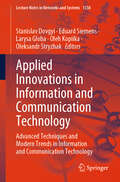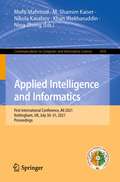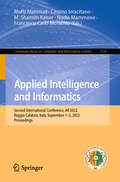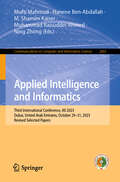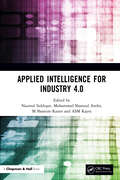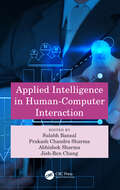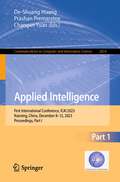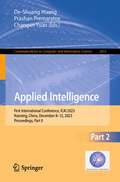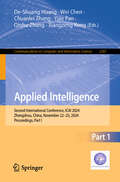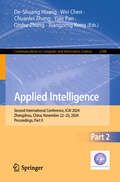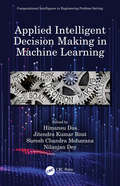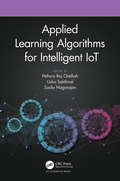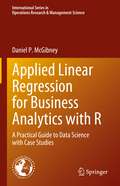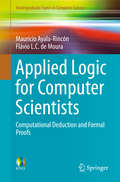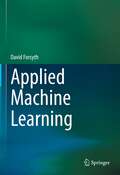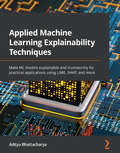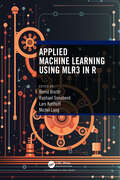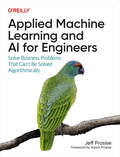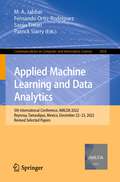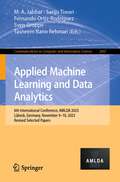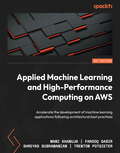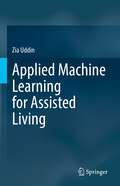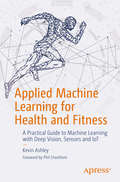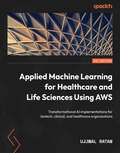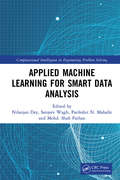- Table View
- List View
Applied Innovations in Information and Communication Technology: Advanced Techniques and Modern Trends in Information and Communication Technology (Lecture Notes in Networks and Systems #1338)
by Larysa Globa Stanislav Dovgyi Eduard Siemens Oleh Kopiika Oleksandr StryzhakThis book highlights the most important research areas in Information and Communication Technologies and their impact on digital society and environment sustainable development namely the research in fields of information and communication technologies, artificial intelligence in ICT, data analytics, security of data and services, reducing energy consumption in the digital environment, and mathematical modeling for practical and research tasks in communication and data processing fields provided by various groups of researchers from Germany and Ukraine in cooperation with scientists from different countries. The presented studies contain a discussion on the use of artificial intelligence, in particular, methods of deep learning, practical implementation of the Internet of Things (IoT), the modern study of ECO monitoring systems; research in fields of mathematical modeling in applied problems. The book focuses on the basics of information and analytical activities in the digital global space, to providing broadband Internet access without decreasing the quality of experience (QoE) level, improving services providing, and system architecture for SDN. The study of modern communication and information technologies contains original works dealing with many aspects of their improvement and use for forecasting social and environment sustainable development based on global information space, as well as research that contains actual papers, which show some effective technological solutions that can be used for the implementation of novel cloud infrastructure and radio electronics systems. These results can be used in the implementation of novel systems and to promote the exchange of information in e-societies. Given its scope the book offers a valuable resource for scientists, lecturers, specialists working at enterprises, graduate and undergraduate students who engage with problems in Information and Communication Technologies as well as aspects of society and environment sustainable development.
Applied Intelligence and Informatics: First International Conference, AII 2021, Nottingham, UK, July 30–31, 2021, Proceedings (Communications in Computer and Information Science #1435)
by Nikola Kasabov Ning Zhong Mufti Mahmud M. Shamim Kaiser Khan IftekharuddinThis book constitutes the refereed proceedings of the First International Conference on Applied Intelligence and Informatics, AII 2021, held in Nottingham, UK, in July 2021. Due to the COVID-19 pandemic the conference was held in a fully virtual mode. The 26 full papers and 4 short papers presented were thoroughly reviewed and selected from the total 107 submissions. They are organized in the following topical sections: application of AI and informatics in disease detection; application of AI and informatics in healthcare; application of AI and informatics in pattern recognition; application of AI and informatics in network, security, and analytics; emerging applications of AI and informatics.
Applied Intelligence and Informatics: Second International Conference, AII 2022, Reggio Calabria, Italy, September 1–3, 2022, Proceedings (Communications in Computer and Information Science #1724)
by Francesco Carlo Morabito Mufti Mahmud M. Shamim Kaiser Cosimo Ieracitano Nadia MammoneThis book constitutes the refereed proceedings of the Second International Conference on Applied Intelligence and Informatics, AII 2022, held in Reggio Calabria, Italy, during September 1–3, 2022. The 38 full papers included in this book were carefully reviewed and selected from 108 submissions. They were organized in topical sections as follows: Emerging Applications of AI and Informatics; Application of AI and Informatics in Healthcare; Application of AI and Informatics in Pattern Recognition; and Application of AI and Informatics in Network, Security, and Analytics.
Applied Intelligence and Informatics: Third International Conference, AII 2023, Dubai, United Arab Emirates, October 29–31, 2023, Revised Selected Papers (Communications in Computer and Information Science #2065)
by Ning Zhong Mufti Mahmud M. Shamim Kaiser Hanene Ben-Abdallah Muhammad Raisuddin AhmedThis book constitutes the refereed post-conference proceedings of the Third International Conference on Applied Intelligence and Informatics, AII 2023, held in Dubai, United Arab Emirates, during October 29–31, 2023. The 31 full papers included in these proceedings were carefully reviewed and selected from 99 submissions. They are organized in these topical sections as follows: Emerging Applications of AI and Informatics; Application of AI and Informatics in Healthcare; Application of AI and Informatics in Pattern Recognition; Application of AI and Informatics in Network, Security, and Analytics.
Applied Intelligence for Industry 4.0
by Nazmul Siddique M Shamim Kaiser Mohammad Shamsul Arefin Asm KayesWe are all aware that artificial intelligence (AI) has brought a change in our lives, driven by a new form of interaction between man and machine. We are in the era of the fourth Industrial Revolution (IR) where AI plays vital roles in human development by enabling extraordinary technological advances making fundamental changes to the way we live, work and relate to one another. It is an opportunity to help everyone, including leaders, policymakers and people from all income groups and nations, to harness converging technologies in order to create an inclusive, human-centered future. We need to prepare our graduates as well as researchers to conduct their research with 4.0 IR-related technologies. We need to develop policies and implement those policies to focus on the components of 4.0 IR for sustainable developments. Applied Intelligence for Industry 4.0 will cover cutting edge topics in the fields of AI and industry 4.0. The text will appeal to beginners and advanced researchers in computer science, information sciences, engineering and robotics. Features Discusses advance data mining, feature extraction and classification algorithms for disease detection, cyber security detection and prevention, soil quality assessment and other industrial applications Includes the parameter optimization and explanation of intelligent approaches for business applications Presents context-aware smart insights and energy efficient and smart computing for the next-generation of smart industry
Applied Intelligence in Human-Computer Interaction
by Abhishek Sharma Sulabh Bansal Prakash Chandra Sharma Jieh-Ren ChangThe text comprehensively discusses the fundamental aspects of human– computer interaction, and applications of artificial intelligence in diverse areas including disaster management, smart infrastructures, and healthcare. It employs a solution-based approach in which recent methods and algorithms are used for identifying solutions to real-life problems. This book: • Discusses the application of artificial intelligence in the areas of user interface development, computing power analysis, and data management. • Uses recent methods/algorithms to present solution-based approaches to real-life problems in different sectors. • Showcases the applications of artificial intelligence and automation techniques to respond to disaster situations. • Covers important topics such as smart intelligence learning, interactive multimedia systems, and modern communication systems. • Highlights the importance of artificial intelligence for smart industrial automation and systems intelligence. The book elaborates on the application of artificial intelligence in user interface development, computing power analysis, and data management. It explores the use of human–computer interaction for intelligence signal and image processing techniques. The text covers important concepts such as modern communication systems, smart industrial automation, interactive multimedia systems, and machine learning interface for the internet of things. It will serve as an ideal text for senior undergraduates, and graduate students in the fields of electrical engineering, electronics and communication engineering, computer engineering, and information technology.
Applied Intelligence: First International Conference, ICAI 2023, Nanning, China, December 8–12, 2023, Proceedings, Part I (Communications in Computer and Information Science #2014)
by Prashan Premaratne De-Shuang Huang Changan YuanThis 2-volume set CCIS 2014 and CCIS 2015 constitutes the post-conference proceedings of the First International Conference on Applied Intelligence, ICAI 2023, held in Nanning, China, December 8–12, 2023.The 64 full papers presented in this proceedings were carefully selected and reviewed from 228 submissions. The papers cover a wide range on theoretical aspects of biomedical data modeling and mining; computer vision; and deep learning. They were organized in topical sections as follows:Part I: Biomedical data modeling and mining; computer vision; deep learning; Part II: Intelligent control and automation; machine learning; natural language processing and computational linguistics.
Applied Intelligence: First International Conference, ICAI 2023, Nanning, China, December 8–12, 2023, Proceedings, Part II (Communications in Computer and Information Science #2015)
by Prashan Premaratne De-Shuang Huang Changan YuanThis 2-volume set CCIS 2014 and CCIS 2015 constitutes the post-conference proceedings of the First International Conference on Applied Intelligence, ICAI 2023, held in Nanning, China, December 8–12, 2023.The 64 full papers presented in this proceedings were carefully selected and reviewed from 228 submissions. The papers cover a wide range on theoretical aspects of biomedical data modeling and mining; computer vision; and deep learning. They were organized in topical sections as follows:Part I: Biomedical data modeling and mining; computer vision; deep learning; Part II: Intelligent control and automation; machine learning; natural language processing and computational linguistics.
Applied Intelligence: Second International Conference, ICAI 2024, Zhengzhou, China, November 22–25, 2024, Proceedings, Part I (Communications in Computer and Information Science #2387)
by Wei Chen De-Shuang Huang Yijie Pan Qinhu Zhang Chuanlei Zhang Xiangzeng KongThis 2-volume set CCIS 2387 + 2388 constitutes the proceedings of the Second International Conference on Applied Intelligence, ICAI 2024, held in Zhengzhou, China, during November 22-25, 2024. The 72 full papers presented in this proceedings were carefully reviewed and selected from 228 submissions. The papers cover a wide range on theoretical aspects of biomedical data modeling and mining; computer vision; and deep learning. They were organized in topical sections as follows: Part I: Biomedical data modeling and mining; information security; pattern recognition; Part II: Image Processing; intelligent data analysis and prediction; machine learning;
Applied Intelligence: Second International Conference, ICAI 2024, Zhengzhou, China, November 22–25, 2024, Proceedings, Part II (Communications in Computer and Information Science #2388)
by Wei Chen De-Shuang Huang Yijie Pan Qinhu Zhang Chuanlei Zhang Xiangzeng KongThis 2-volume set CCIS 2387 + 2388 constitutes the proceedings of the Second International Conference on Applied Intelligence, ICAI 2024, held in Zhengzhou, China, during November 22-25, 2024. The 72 full papers presented in this proceedings were carefully reviewed and selected from 228 submissions. The papers cover a wide range on theoretical aspects of biomedical data modeling and mining; computer vision; and deep learning. They were organized in topical sections as follows: Part I: Biomedical data modeling and mining; information security; pattern recognition; Part II: Image Processing; intelligent data analysis and prediction; machine learning;
Applied Intelligent Decision Making in Machine Learning (Computational Intelligence in Engineering Problem Solving)
by Nilanjan Dey Himansu Das Jitendra Kumar Rout Suresh Chandra MoharanaThe objective of this edited book is to share the outcomes from various research domains to develop efficient, adaptive, and intelligent models to handle the challenges related to decision making. It incorporates the advances in machine intelligent techniques such as data streaming, classification, clustering, pattern matching, feature selection, and deep learning in the decision-making process for several diversified applications such as agriculture, character recognition, landslide susceptibility, recommendation systems, forecasting air quality, healthcare, exchange rate prediction, and image dehazing. It also provides a premier interdisciplinary platform for scientists, researchers, practitioners, and educators to share their thoughts in the context of recent innovations, trends, developments, practical challenges, and advancements in the field of data mining, machine learning, soft computing, and decision science. It also focuses on the usefulness of applied intelligent techniques in the decision-making process in several aspects. To address these objectives, this edited book includes a dozen chapters contributed by authors from around the globe. The authors attempt to solve these complex problems using several intelligent machine-learning techniques. This allows researchers to understand the mechanism needed to harness the decision-making process using machine-learning techniques for their own respective endeavors.
Applied Learning Algorithms for Intelligent IoT
by Pethuru Raj ChelliahThis book vividly illustrates all the promising and potential machine learning (ML) and deep learning (DL) algorithms through a host of real-world and real-time business use cases. Machines and devices can be empowered to self-learn and exhibit intelligent behavior. Also, Big Data combined with real-time and runtime data can lead to personalized, prognostic, predictive, and prescriptive insights. This book examines the following topics: Cognitive machines and devices Cyber physical systems (CPS) The Internet of Things (IoT) and industrial use cases Industry 4.0 for smarter manufacturing Predictive and prescriptive insights for smarter systems Machine vision and intelligence Natural interfaces K-means clustering algorithm Support vector machine (SVM) algorithm A priori algorithms Linear and logistic regression Applied Learning Algorithms for Intelligent IoT clearly articulates ML and DL algorithms that can be used to unearth predictive and prescriptive insights out of Big Data. Transforming raw data into information and relevant knowledge is gaining prominence with the availability of data processing and mining, analytics algorithms, platforms, frameworks, and other accelerators discussed in the book. Now, with the emergence of machine learning algorithms, the field of data analytics is bound to reach new heights. This book will serve as a comprehensive guide for AI researchers, faculty members, and IT professionals. Every chapter will discuss one ML algorithm, its origin, challenges, and benefits, as well as a sample industry use case for explaining the algorithm in detail. The book’s detailed and deeper dive into ML and DL algorithms using a practical use case can foster innovative research.
Applied Linear Regression for Business Analytics with R: A Practical Guide to Data Science with Case Studies (International Series in Operations Research & Management Science #337)
by Daniel P. McGibneyApplied Linear Regression for Business Analytics with R introduces regression analysis to business students using the R programming language with a focus on illustrating and solving real-time, topical problems. Specifically, this book presents modern and relevant case studies from the business world, along with clear and concise explanations of the theory, intuition, hands-on examples, and the coding required to employ regression modeling. Each chapter includes the mathematical formulation and details of regression analysis and provides in-depth practical analysis using the R programming language.
Applied Logic for Computer Scientists: Computational Deduction and Formal Proofs (Undergraduate Topics in Computer Science)
by Mauricio Ayala-Rincón Flávio L. C. de MouraThis book provides an introduction to logic and mathematical induction which are the basis of any deductive computational framework. A strong mathematical foundation of the logical engines available in modern proof assistants, such as the PVS verification system, is essential for computer scientists, mathematicians and engineers to increment their capabilities to provide formal proofs of theorems and to certify the robustness of software and hardware systems. <P><P> The authors present a concise overview of the necessary computational and mathematical aspects of ‘logic’, placing emphasis on both natural deduction and sequent calculus. Differences between constructive and classical logic are highlighted through several examples and exercises. Without neglecting classical aspects of computational logic, the authors also highlight the connections between logical deduction rules and proof commands in proof assistants, presenting simple examples of formalizations of the correctness of algebraic functions and algorithms in PVS. <P> Applied Logic for Computer Scientists will not only benefit students of computer science and mathematics but also software, hardware, automation, electrical and mechatronic engineers who are interested in the application of formal methods and the related computational tools to provide mathematical certificates of the quality and accuracy of their products and technologies.
Applied Machine Learning
by David ForsythMachine learning methods are now an important tool for scientists, researchers, engineers and students in a wide range of areas. This book is written for people who want to adopt and use the main tools of machine learning, but aren’t necessarily going to want to be machine learning researchers. Intended for students in final year undergraduate or first year graduate computer science programs in machine learning, this textbook is a machine learning toolkit. Applied Machine Learning covers many topics for people who want to use machine learning processes to get things done, with a strong emphasis on using existing tools and packages, rather than writing one’s own code.A companion to the author's Probability and Statistics for Computer Science, this book picks up where the earlier book left off (but also supplies a summary of probability that the reader can use).Emphasizing the usefulness of standard machinery from applied statistics, this textbook gives an overview of the major applied areas in learning, including coverage of:• classification using standard machinery (naive bayes; nearest neighbor; SVM)• clustering and vector quantization (largely as in PSCS)• PCA (largely as in PSCS)• variants of PCA (NIPALS; latent semantic analysis; canonical correlation analysis)• linear regression (largely as in PSCS)• generalized linear models including logistic regression• model selection with Lasso, elasticnet• robustness and m-estimators• Markov chains and HMM’s (largely as in PSCS)• EM in fairly gory detail; long experience teaching this suggests one detailed example is required, which students hate; but once they’ve been through that, the next one is easy• simple graphical models (in the variational inference section)• classification with neural networks, with a particular emphasis onimage classification• autoencoding with neural networks• structure learning
Applied Machine Learning Explainability Techniques: Make ML models explainable and trustworthy for practical applications using LIME, SHAP, and more
by Aditya BhattacharyaLeverage top XAI frameworks to explain your machine learning models with ease and discover best practices and guidelines to build scalable explainable ML systemsKey FeaturesExplore various explainability methods for designing robust and scalable explainable ML systemsUse XAI frameworks such as LIME and SHAP to make ML models explainable to solve practical problemsDesign user-centric explainable ML systems using guidelines provided for industrial applicationsBook DescriptionExplainable AI (XAI) is an emerging field that brings artificial intelligence (AI) closer to non-technical end users. XAI makes machine learning (ML) models transparent and trustworthy along with promoting AI adoption for industrial and research use cases.Applied Machine Learning Explainability Techniques comes with a unique blend of industrial and academic research perspectives to help you acquire practical XAI skills. You'll begin by gaining a conceptual understanding of XAI and why it's so important in AI. Next, you'll get the practical experience needed to utilize XAI in AI/ML problem-solving processes using state-of-the-art methods and frameworks. Finally, you'll get the essential guidelines needed to take your XAI journey to the next level and bridge the existing gaps between AI and end users.By the end of this ML book, you'll be equipped with best practices in the AI/ML life cycle and will be able to implement XAI methods and approaches using Python to solve industrial problems, successfully addressing key pain points encountered.What you will learnExplore various explanation methods and their evaluation criteriaLearn model explanation methods for structured and unstructured dataApply data-centric XAI for practical problem-solvingHands-on exposure to LIME, SHAP, TCAV, DALEX, ALIBI, DiCE, and othersDiscover industrial best practices for explainable ML systemsUse user-centric XAI to bring AI closer to non-technical end usersAddress open challenges in XAI using the recommended guidelinesWho this book is forThis book is for scientists, researchers, engineers, architects, and managers who are actively engaged in machine learning and related fields. Anyone who is interested in problem-solving using AI will benefit from this book. Foundational knowledge of Python, ML, DL, and data science is recommended. AI/ML experts working with data science, ML, DL, and AI will be able to put their knowledge to work with this practical guide. This book is ideal for you if you're a data and AI scientist, AI/ML engineer, AI/ML product manager, AI product owner, AI/ML researcher, and UX and HCI researcher.
Applied Machine Learning Using mlr3 in R
by Lars Kotthoff Bernd Bischl Raphael Sonabend Michel Langmlr3 is an award-winning ecosystem of R packages that have been developed to enable state-of-the-art machine learning capabilities in R. Applied Machine Learning Using mlr3 in R gives an overview of flexible and robust machine learning methods, with an emphasis on how to implement them using mlr3 in R. It covers various key topics, including basic machine learning tasks, such as building and evaluating a predictive model; hyperparameter tuning of machine learning approaches to obtain peak performance; building machine learning pipelines that perform complex operations such as pre-processing followed by modelling followed by aggregation of predictions; and extending the mlr3 ecosystem with custom learners, measures, or pipeline components. Features: In-depth coverage of the mlr3 ecosystem for users and developers Explanation and illustration of basic and advanced machine learning concepts Ready to use code samples that can be adapted by the user for their application Convenient and expressive machine learning pipelining enabling advanced modelling Coverage of topics that are often ignored in other machine learning books The book is primarily aimed at researchers, practitioners, and graduate students who use machine learning or who are interested in using it. It can be used as a textbook for an introductory or advanced machine learning class that uses R, as a reference for people who work with machine learning methods, and in industry for exploratory experiments in machine learning.
Applied Machine Learning and AI for Engineers: Solve Business Problems That Can't Be Solved Algorithmically
by Jeff ProsiseWhile many introductory guides to AI are calculus books in disguise, this one mostly eschews the math. Instead, author Jeff Prosise helps engineers and software developers build an intuitive understanding of AI to solve business problems. Need to create a system to detect the sounds of illegal logging in the rainforest, analyze text for sentiment, or predict early failures in rotating machinery? This practical book teaches you the skills necessary to put AI and machine learning to work at your company. Applied Machine Learning and AI for Engineers provides examples and illustrations from the AI and ML course Prosise teaches at companies and research institutions worldwide. There's no fluff and no scary equations—just a fast start for engineers and software developers, complete with hands-on examples. This book helps you: Learn what machine learning and deep learning are and what they can accomplishUnderstand how popular learning algorithms work and when to apply themBuild machine learning models in Python with Scikit-Learn, and neural networks with Keras and TensorFlowTrain and score regression models and binary and multiclass classification modelsBuild facial recognition models and object detection modelsBuild language models that respond to natural-language queries and translate text to other languagesUse Cognitive Services to infuse AI into the apps that you write
Applied Machine Learning and Data Analytics: 5th International Conference, AMLDA 2022, Reynosa, Tamaulipas, Mexico, December 22–23, 2022, Revised Selected Papers (Communications in Computer and Information Science #1818)
by Patrick Siarry M. A. Jabbar Sanju Tiwari Fernando Ortiz-RodríguezThis book constitutes the refereed proceedings of the 5th International Conference on Applied Machine Learning and Data Analytics, AMLDA 2022, held in Reynosa, Tamaulipas, Mexico, during December 22–23, 2022. The 16 full papers and 4 short papers included in this book were carefully reviewed and selected from 89 submissions. They were organized in topical sections as follows: Machine learning, Healthcare and medical imaging informatics; biometrics; forensics; precision agriculture; risk management; robotics and satellite imaging.
Applied Machine Learning and Data Analytics: 6th International Conference, AMLDA 2023, Lübeck, Germany, November 9–10, 2023, Revised Selected Papers (Communications in Computer and Information Science #2047)
by Sven Groppe M. A. Jabbar Sanju Tiwari Fernando Ortiz-Rodríguez Tasneem Bano RehmanThis book constitutes the refereed conference proceedings of the 6th International Conference on Applied Machine Learning and Data Analytics, AMLDA 2023, held in Lübeck, Germany, during November 9–10, 2023.The 17 full papers and 2 short papers presented in this book were carefully reviewed and selected from 76 submissions. The main conference AMLDA 2023 is renowned for presenting cutting-edge research on all aspects of machine learning as well as important application areas such as healthcare and medical imaging informatics, biometrics, forensics, precision agriculture, risk management, robotics, and satellite imaging.
Applied Machine Learning and High-Performance Computing on AWS: Accelerate the development of machine learning applications following architectural best practices
by Shreyas Subramanian Trenton Potgieter Mani Khanuja Farooq SabirBuild, train, and deploy large machine learning models at scale in various domains such as computational fluid dynamics, genomics, autonomous vehicles, and numerical optimization using Amazon SageMakerKey FeaturesUnderstand the need for high-performance computing (HPC)Build, train, and deploy large ML models with billions of parameters using Amazon SageMakerLearn best practices and architectures for implementing ML at scale using HPCBook DescriptionMachine learning (ML) and high-performance computing (HPC) on AWS run compute-intensive workloads across industries and emerging applications. Its use cases can be linked to various verticals, such as computational fluid dynamics (CFD), genomics, and autonomous vehicles.This book provides end-to-end guidance, starting with HPC concepts for storage and networking. It then progresses to working examples on how to process large datasets using SageMaker Studio and EMR. Next, you'll learn how to build, train, and deploy large models using distributed training. Later chapters also guide you through deploying models to edge devices using SageMaker and IoT Greengrass, and performance optimization of ML models, for low latency use cases.By the end of this book, you'll be able to build, train, and deploy your own large-scale ML application, using HPC on AWS, following industry best practices and addressing the key pain points encountered in the application life cycle.What you will learnExplore data management, storage, and fast networking for HPC applicationsFocus on the analysis and visualization of a large volume of data using SparkTrain visual transformer models using SageMaker distributed trainingDeploy and manage ML models at scale on the cloud and at the edgeGet to grips with performance optimization of ML models for low latency workloadsApply HPC to industry domains such as CFD, genomics, AV, and optimizationWho this book is forThe book begins with HPC concepts, however, it expects you to have prior machine learning knowledge. This book is for ML engineers and data scientists interested in learning advanced topics on using large datasets for training large models using distributed training concepts on AWS, deploying models at scale, and performance optimization for low latency use cases. Practitioners in fields such as numerical optimization, computation fluid dynamics, autonomous vehicles, and genomics, who require HPC for applying ML models to applications at scale will also find the book useful.
Applied Machine Learning for Assisted Living
by Zia UddinUser care at home is a matter of great concern since unforeseen circumstances might occur that affect people's well-being. Technologies that assist people in independent living are essential for enhancing care in a cost-effective and reliable manner. Assisted care applications often demand real-time observation of the environment and the resident’s activities using an event-driven system. As an emerging area of research and development, it is necessary to explore the approaches of the user care system in the literature to identify current practices for future research directions. Therefore, this book is aimed at a comprehensive review of data sources (e.g., sensors) with machine learning for various smart user care systems. To encourage the readers in the field, insights of practical essence of different machine learning algorithms with sensor data (e.g., publicly available datasets) are also discussed. Some code segments are also included to motivate the researchers of the related fields to practically implement the features and machine learning techniques. It is an effort to obtain knowledge of different types of sensor-based user monitoring technologies in-home environments. With the aim of adopting these technologies, research works, and their outcomes are reported. Besides, up to date references are included for the user monitoring technologies with the aim of facilitating independent living.Research that is related to the use of user monitoring technologies in assisted living is very widespread, but it is still consists mostly of limited-scale studies. Hence, user monitoring technology is a very promising field, especially for long-term care. However, monitoring of the users for smart assisted technologies should be taken to the next level with more detailed studies that evaluate and demonstrate their potential to contribute to prolonging the independent living of people. The target of this book is to contribute towards that direction.
Applied Machine Learning for Health and Fitness: A Practical Guide to Machine Learning with Deep Vision, Sensors and IoT
by Kevin AshleyExplore the world of using machine learning methods with deep computer vision, sensors and data in sports, health and fitness and other industries. Accompanied by practical step-by-step Python code samples and Jupyter notebooks, this comprehensive guide acts as a reference for a data scientist, machine learning practitioner or anyone interested in AI applications. These ML models and methods can be used to create solutions for AI enhanced coaching, judging, athletic performance improvement, movement analysis, simulations, in motion capture, gaming, cinema production and more.Packed with fun, practical applications for sports, machine learning models used in the book include supervised, unsupervised and cutting-edge reinforcement learning methods and models with popular tools like PyTorch, Tensorflow, Keras, OpenAI Gym and OpenCV. Author Kevin Ashley—who happens to be both a machine learning expert and a professional ski instructor—has written an insightful book that takes you on a journey of modern sport science and AI. Filled with thorough, engaging illustrations and dozens of real-life examples, this book is your next step to understanding the implementation of AI within the sports world and beyond. Whether you are a data scientist, a coach, an athlete, or simply a personal fitness enthusiast excited about connecting your findings with AI methods, the author’s practical expertise in both tech and sports is an undeniable asset for your learning process. Today’s data scientists are the future of athletics, and Applied Machine Learning for Health and Fitness hands you the knowledge you need to stay relevant in this rapidly growing space.What You'll LearnUse multiple data science tools and frameworksApply deep computer vision and other machine learning methods for classification, semantic segmentation, and action recognitionBuild and train neural networks, reinforcement learning models and moreAnalyze multiple sporting activities with deep learningUse datasets available today for model trainingUse machine learning in the cloud to train and deploy modelsApply best practices in machine learning and data scienceWho This Book Is ForPrimarily aimed at data scientists, coaches, sports enthusiasts and athletes interested in connecting sports with technology and AI methods.
Applied Machine Learning for Healthcare and Life Sciences Using AWS: Transformational AI implementations for biotech, clinical, and healthcare organizations
by Ujjwal RatanBuild real-world artificial intelligence apps on AWS to overcome challenges faced by healthcare providers and payers, as well as pharmaceutical, life sciences research, and commercial organizationsKey FeaturesLearn about healthcare industry challenges and how machine learning can solve themExplore AWS machine learning services and their applications in healthcare and life sciencesDiscover practical coding instructions to implement machine learning for healthcare and life sciencesBook DescriptionWhile machine learning is not new, it's only now that we are beginning to uncover its true potential in the healthcare and life sciences industry. The availability of real-world datasets and access to better compute resources have helped researchers invent applications that utilize known AI techniques in every segment of this industry, such as providers, payers, drug discovery, and genomics. This book starts by summarizing the introductory concepts of machine learning and AWS machine learning services. You'll then go through chapters dedicated to each segment of the healthcare and life sciences industry. Each of these chapters has three key purposes -- First, to introduce each segment of the industry, its challenges, and the applications of machine learning relevant to that segment. Second, to help you get to grips with the features of the services available in the AWS machine learning stack like Amazon SageMaker and Amazon Comprehend Medical. Third, to enable you to apply your new skills to create an ML-driven solution to solve problems particular to that segment. The concluding chapters outline future industry trends and applications. By the end of this book, you'll be aware of key challenges faced in applying AI to healthcare and life sciences industry and learn how to address those challenges with confidence.What you will learnExplore the healthcare and life sciences industryFind out about the key applications of AI in different industry segmentsApply AI to medical images, clinical notes, and patient dataDiscover security, privacy, fairness, and explainability best practicesExplore the AWS ML stack and key AI services for the industryDevelop practical ML skills using code and AWS servicesDiscover all about industry regulatory requirementsWho this book is forThis book is specifically tailored toward technology decision-makers, data scientists, machine learning engineers, and anyone who works in the data engineering role in healthcare and life sciences organizations. Whether you want to apply machine learning to overcome common challenges in the healthcare and life science industry or are looking to understand the broader industry AI trends and landscape, this book is for you. This book is filled with hands-on examples for you to try as you learn about new AWS AI concepts.
Applied Machine Learning for Smart Data Analysis (Computational Intelligence in Engineering Problem Solving)
by Nilanjan Dey Sanjeev Wagh Parikshit Mahalle Mohd. PathanThe book focusses on how machine learning and Internet of Things (IoT) has empowered the advancement of information driven arrangements including key concepts and advancements. Divided into sections such as machine learning, security, IoT and data mining, the concepts are explained with practical implementation including results.
